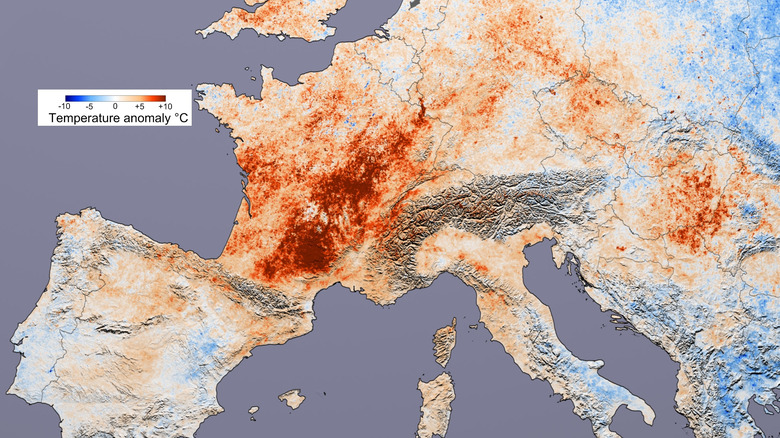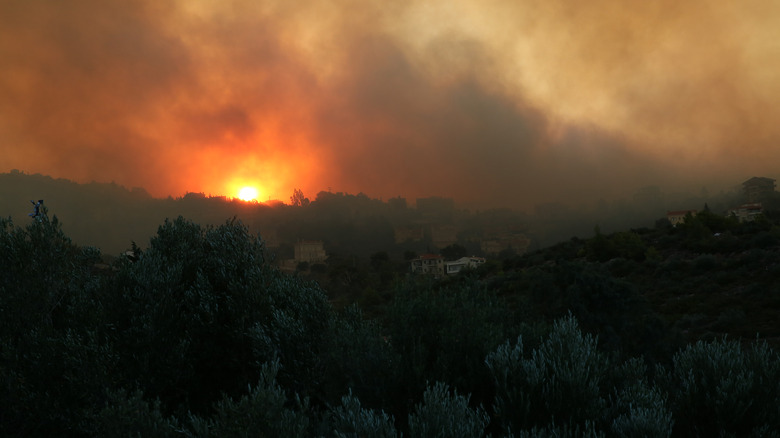The Tragic True Story Of The 2003 European Heat Wave
During the summer of 2022, Europe was hit by an extreme heat wave. Temperatures soared with countries setting record highs, and with forest fires raging for weeks on end, leading to the evacuation of thousands of people.
But this wasn't the first time, of course, Europe faced a relentless heat wave. In fact, a historic one happened not long before. In 2003, the continent experienced one of the worst heat waves Europe had experienced in hundreds of years. And so unprepared were the countries for the heat that tens of thousands of people across Europe lost their lives as a result of the temperatures.
Back in December 2014, a study published in Nature Climate Change showed that not only was a repeat of the 2003 heat wave likely for Europe, but the continent was 10 times more likely to see similar heat conditions a decade later due to man-made climate change. And as Europe has continued to see increasingly warmer summers every year, it's likely that the 2003 heat wave was a harbinger of things to come — like in 2022.
European countries have since taken steps to prevent a mass mortality event like the one in the summer of 2003. But as temperature records seemingly break every summer, it's worth looking back at one of the most devastating heat waves ever in Europe to make sure that such a catastrophe never happens again. This is the tragic true story of the 2003 European heat wave.
Hottest summer since 1540
During the summer of 2003, European countries saw temperatures skyrocket. The heat wave began in June and lasted until mid-August, and according to the UN Environment Programme, temperatures were 30% higher than average. Temperatures were extreme, reaching the mid-90s and peaking at 104 degrees Fahrenheit. Countries saw all-time maximum temperatures; the United Kingdom, for example, record a high of 100.6 F.
This heat wave was practically unprecedented. According to "Global Climate Change and Human Health: From Science to Practice," the 2003 European heat wave was the hottest summer on record for Europe since 1540. In Switzerland alone, that June was the hottest month to be recorded in 250 years.
According to an analysis of grape harvest dates in the Burgundy region of France, it's estimated that temperatures during the 2003 European heat wave were the highest since 1370, via Climate of the Past; meanwhile, a study of tree-ring maximum latewood density measurements estimated that the summer was the warmest since 755 CE.
With this said, most evidence suggests that the temperatures in 1540 were significantly warmer than in 2003. That heat wave in 1540 was ultimately considered worse due to the fact that it lasted longer and its associated drought sustained for 11 months, according to "Climate Change and Cultural Transition in Europe."
Up to 70,000 excess deaths
During the 2003 European heat wave, at least 70,000 people died as a result, with two-thirds of those deaths occurring in August. As reported in Comptes Rendus Biologies, even up to three years after the heat wave, the total number of victims remained unknown, with data from 16 European countries suggesting there may even have been even more related deaths.
In France, between 15,000 and 19,000 people died, which was "55% higher than expected without a heat wave," according to Gail Carlson, an associate professor of environmental studies and director of the Buck Lab for Climate and Environment at Colby College. In her book "Human Health and the Climate Crisis," Carlson noted that it was the most deaths recorded during a summer season since World War II.
In Paris, there was an excess death rate of 141%. In Italy, the country saw over 20,000 excess deaths. Many of the heat wave victims were elderly and the International Archives of Occupational and Environmental Health writes that the causes of death ranged from heat stroke and hyperthermia to cardiovascular diseases, respiratory diseases, and nervous system diseases. Per a research paper in Critical Care, those living alone or in poor socioeconomic conditions were especially vulnerable to the prolonged temperature highs in 2003.
Due to the high mortality rate in Paris, hospital mortuaries overflowed and refrigerated trucks had to be brought in. But in England, where there were over 2,000 excess deaths, the increase in dead bodies was absorbed by the crematoria (via The Conversation).
France hit hard
As noted, France was hit especially hard by the heat wave in 2003. Because most of the deaths occurred over a three-week period between August 1 and August 20, when most of the country was on its annual vacation, large numbers of hospital staff were away and relatives weren't around to claim the bodies, according to "Victimology: Theories and Applications." Some bodies weren't claimed for weeks and over 50 bodies were still unclaimed when they were buried.
Europe's agriculture sector was impacted to a historic extent. Crop yields were negatively affected by the heat wave and the subsequent drought. As reported in Climatic Change, the 2003 heat wave in France was the cause of a 55% loss in maize output for the entire continent. It's estimated that France's agricultural sector lost over $4 billion.
The heat wave also affected France's power production. Because nuclear power plants use river water to cool reactors, France had to shut down the equivalent of four nuclear power plants because the river water levels were so low, per The Guardian. At the same time, the demand for electricity skyrocketed and France had to cut its power exports by more than half (via the UN Environment Programme).
Per the European Journal of Public Health, the 2003 heat wave had been the worst on record for France since 1873.
Wheat and maize production falls
As said, the heat wave and drought in 2003 severely affected crop production across Europe. The Guardian reports that some countries had faced their worst harvests that year since World War II.
According to Climatic Change, wheat production in France fell by 21.5% and maize production fell by 30%. Throughout Europe, crops were ruined, especially wheat. Moldova saw its harvests drop by 80% as almost half of its wheat crops suffered. Per Voices of America News, Germany also reported losses in gain production of up to 80%. Countries like Italy and the United Kingdom also lost up to 13% of their wheat. Ukraine, described as the breadbasket of Europe (to this day), was hit especially hard, seeing its wheat harvest drop by 75% (via The Guardian).
Fruit harvests in France also saw a 25% reduction in yield as a result of the 2003 heat wave. Incredibly, as reported in Environmental Health Perspectives, the global food trade generally prevented food shortages, despite the massive drops in output from many of Europe's biggest producers.
With this said, the European Environmental Agency estimates that Europe's heat wave in 2003 led to a loss of over $10 billion in farming, livestock, and forestry.
Alpine glaciers affected
Alpine mountains and glaciers were also severely affected by the 2003 European heat wave. According to the UN Environment Programme, Alpine glaciers lost up to 10% of their volume. The average loss in thickness was recorded to be almost 10 feet in water equivalent, which was double what had been the previous record from 1998.
The heat wave also shut down the Matterhorn. The famous Alpine peak became too dangerous to climb for the first time in over 225 years, per "Adapting Buildings and Cities for Climate Change." Due to the record heat, the permafrost that held the Matterhorn's peaks together melted down to a depth of 7 feet. As a result, ski lifts and cable cars were unstable. And after a rock avalanche occurred in July, the mountain was closed. In a historic rescue mission, over 70 climbers had to be rescued from the famous mountain after the rockface crumbled.
Another consequence of the combination of record temperatures and melting snow? Deutsche Welle also reported that avalanches on the mountain's peak led to flash floods down the valley in Switzerland.
Wildfires across Europe
Wildfires were a frequent occurrence during the 2003 European heat wave. Over 50,000 wildfires were recorded in Portugal, Spain, Italy, France, Austria, Finland, Denmark, Ireland, and Greece, according to the "Handbook of Hazards and Disaster Risk Reduction." Per the UN Environment Programme, in Portugal alone, over 390,000 hectares of forest were burned, approximately 5.6% of the country's forest area and encompassing an area larger than Luxembourg. In total, at least 650,000 hectares of forest burned in Europe.
According to the report "Heat waves and forest fires: Summer 2003 in Portugal," the European continent's 2003 heat wave was so intense that forest fires in Portugal, usually concentrated in the northern and central parts of the country, also erupted in the south. At least 20 people lost their lives in fire-related accidents, including four firefighters. The air quality in Western Europe was also affected due to the raging wildfires. This was reportedly the worst fire season that Portugal had faced in over 20 years.
Russia also saw wildfires as far east as Siberia, where its people saw the largest fires in at least a decade (via Atmospheric Chemistry and Physics Discussions).
Hot seas and dry rivers
As the heat wave persisted, bodies of water also found their temperatures rising. According to "Land Degradation, Desertification and Climate Change," the river flow of the Danube in Serbia reached its lowest level in a century. And as previously submerged bombs and tanks from World War II reappeared, swimming in the river became too dangerous.
The Mediterranean Sea off the coast of Spain was recorded as having a surface temperature of 78.3 degrees Fahrenheit, the highest ever recorded at the time, according to the American Meteorological Society. (This was surpassed in 2018 when the Mediterranean Sea's surface temperature hit 78.5 F, via Regional Studies in Marine Science.)
Meanwhile, in "Marine Conservation," P. Keith Probert explains that at least 25 species of sea creatures that live on the seafloor, including nine sea sponges, experienced mass mortality due to the high sea temperatures. In 2003, at least 50,000 fish also died in the Rhine river due to low levels and the rising temperature of the river's water.
And France wasn't the only country that had to scale back its nuclear power due to low river flows. Germany also closed two nuclear power plants due to a lack of water. Public water supplies were also threatened as reservoirs and rivers dried up or ran low.
A French parliamentary inquiry
After the heat wave killed tens of thousands of people in France, Prime Minister Jean-Pierre Raffarin ordered an official parliamentary inquiry to determine exactly how many people died during the heat wave and the reasons behind the mass mortality.
According to the Intergovernmental Panel on Climate Change, the parliamentary inquiry concluded that "the health impact was 'unforeseen', surveillance for heat wave deaths was inadequate, and the limited public health response was due to a lack of experts, limited strength of public health agencies, and poor exchange of information between public organizations."
The parliamentary inquiry also found there were almost no studies done before 2003 about the consequences of heat waves. As a result, the French health and safety agencies and the French agency for environmental health safety didn't include anything on heat waves in their work (via "Extreme Weather Events and Public Health Responses").
Ultimately, as noted in "Experiencing Cities," the 37-page report blamed the nation's health care system for the large number of deaths, which had experienced severe cutbacks during previous administrations, including under the conservatives and the socialists. Other services like retirement homes had also experienced cutbacks that contributed to the mass mortality during the heat wave.
Installing heat health warning systems
At the time of the heat wave, Lisbon and Rome were the only European countries with operational heat health warning systems or HHWS. But after the 2003 heat wave, France, Italy, Germany, Spain, and the United Kingdom all implemented their own heat wave plans by the following year in order to reduce heat wave mortality in the future. By 2006, there were HHWS in 16 different countries and by 2009, there were 28 operational HHWS in Europe, according to "Integrated Risk Governance."
As explained in the International Journal of Epidemiology, the HHWS is intended to give public authorities a warning three days before a heat wave is to occur in order to put the National Heat Wave Plan into motion.
Most HHWS have several levels of response, including media announcements and alerts to hospital emergency rooms. However, according to the European Journal of Public Health, although the 2003 European heat wave underscored the need for a variety of public health measures to reduce the health burden, HHWS have been the main measures implemented.
Inside Climate News notes that although the heat wave in 2012 was almost as hot as 2003, it wasn't as deadly due to the HHWS implementations.
Linked to climate change
After the 2003 European heat wave, numerous studies by climatologists found man-made climate change to be primarily responsible for the devastatingly high temperatures. Nature reports that when incorporating man-made emissions into climate simulations, summer temperatures were found to be a half-degree higher than without human contributions. One study done the following year calculated that "human influences doubled the likelihood of the 2003 heat wave."
Published in Environmental Research Letters in 2016, another comparative study on the 2003 European heat wave found that man-made climate change increased the likelihood of heat-related deaths in London by 20% and increased the likelihood in Paris by 70%. This was the first model to make a direct link between climate change and premature deaths.
According to the study, 506 out of 735 summer deaths in Paris were attributed to a "heat wave made worse by man-made climate change" (via University of Oxford). And although this particular study focused only on London and Paris, numerous cities across Europe saw increased mortality during the 2003 European heat wave.
Per Comptes Rendus Biologies, after witnessing all the excess deaths during the 2003 heat wave, global warming and climate change were designated as "a new health threat in an aged Europe."
New records every year
Despite the fact the 2003 European heat wave broke numerous records with its high temperatures, those records wouldn't last long. As reported in The Lancet, on June 28, 2019, a weather station in France recorded a temperature of 114.6 degrees Fahrenheit, breaking the previous temperature record that was set during the 2003 European heat wave by over three degrees. The United Kingdom also saw its temperature record broken in 2019 as temperatures hit a high of 102 F.
But even these records were soon broken. During the summer of 2022, European countries once again saw themselves in the midst of another record-breaking heat wave. The Met Office reports that on July 19, temperatures in the United Kingdom exceeded 104 F, breaking the previous record set in 2019 by two degrees. Due to the high temperatures, London also saw an increase in fires across the city, per Deutsche Welle.
Many records broken in the summer of 2022 happened as early as June. The Washington Post reports that on June 18, the countrywide temperature average in France rose to 81.3 F, which, according to the paper, was the warmest temperature seen that early in 75 years. At least three other French cities also saw all-time records hit in June of 2022. Other countries that also saw records broken by June included Poland and Germany.
Wildfires in France, Greece, and Italy have also forced the evacuations of thousands of people and in Germany, 10 out of 16 states have issued the country's highest forest fire alert warnings.











